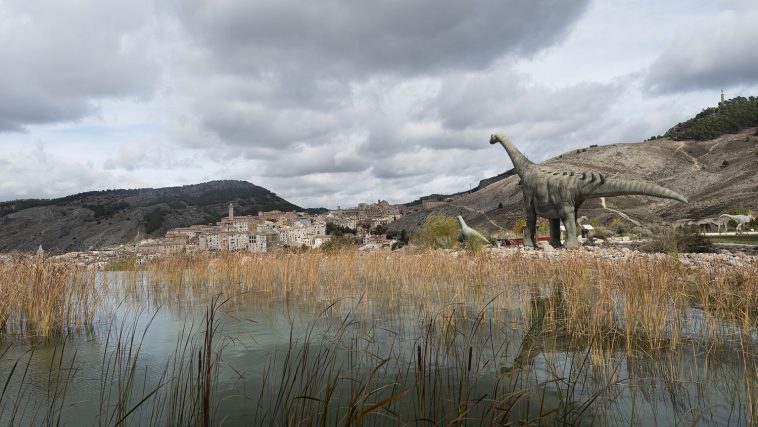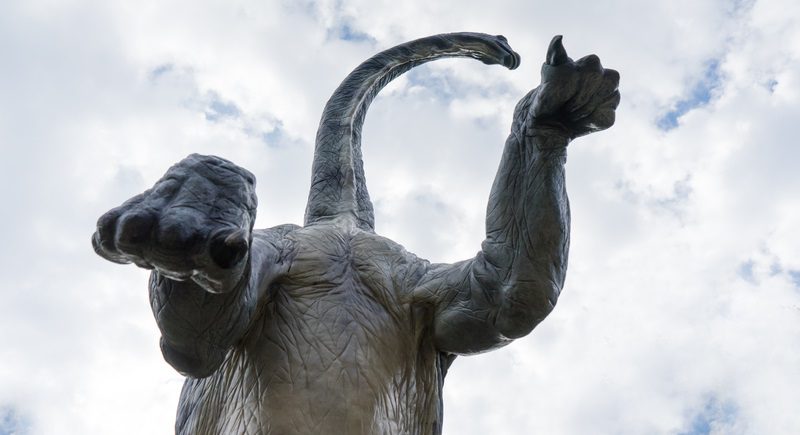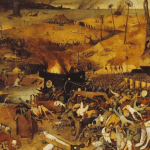[Originally published as part of Echoes of the Jurassic]
Dinosaurs: Chief Among God’s Way
Dinosaurs are fascinating creatures not just to little ones, but to adults too. These reptilian-like critters are perfect for a child’s imaginary world. They come in all sizes and shapes, yet they are extinct. They have the added quality of being gigantic and scary.
Unlike modern lions, tigers, wolves, and any other animals that are known to be dangerous and menacing, children can’t see these amazing creatures in the context of today’s reality. For children and parents alike, these creatures do not exist in our present world, so why not relax and have fun with them?
Why not pay attention to these mysterious creatures?
They have left behind a trail of fossil remains that have turned science upside down, and they have given us a glimpse of the past that appears far different than the world we live in today.
It was the well-known British paleontologist Richard Owen (1804-1892) who first introduced the term “Dinosauria” during an 1841 presentation of his research at the Academy of the British Association of Science. The term was derived from ancient Greek “deinos,” that Owen originally defined as meaning “fearfully great,” and “sauros,” for lizard or reptile.
It was in the following year that the dinosaur was formally classified as a “terrible lizard,” a large reptilian creature that walked upright. The huge bone fossils of several creatures, including Sea Dragons, discovered at that time represented some sort of enormous reptiles that had never been seen before. Owen would classify dinosaurs as a suborder of reptile.
In Job 40, the Bible mentions dinosaur-like creatures with a detailed description of a large terrestrial animal called “Behemoth.” In this chapter, God is speaking to Job and setting the stage where He will question him. In verse 7, God begins, “Now prepare yourself like a man; I will question you and you shall answer Me.”
God declares His majesty by showing Job a giant beast of the field. This Behemoth is described as an herbivore in verse 15, “who eats grass like an ox,” and lives at the same time as man. In verses 16–18, the emphasis is placed on the hips being strong, its powerful abdomen (stomach) muscles, a very huge tail (like a cedar tree), and thighs that are pronounced with a tightly-knit muscular structure. Though like beams of bronze, his bones are agile, designed to move with a strong rib cage that is hard to penetrate (like bars of iron).
There are many commentaries that refer to this creature as today’s elephant or hippopotamus. However, these theories do not line up with the biblical description. Saying that this creature’s tail is like a cedar tree contradicts what these commentators are suggesting.
Most important to note is the description in verse 19 which states,
He is the first of the ways of God. Only He who made him can bring near his sword.
This leads us to the conclusion that this creature was not only strong and muscular, but it had to be massively large like the Brachiosaurus. This dinosaur could have easily towered over a man standing almost 40 feet tall and weighing 62 tons. Brachiosaurus was accurately portrayed in the first blockbuster film Jurassic Park (1993). It was introduced at the beginning of the film, while everything was calm and peaceful, before the terror began as a T. rex and other scary creatures were released and ran wild.
The scene portrays the gigantic Brachiosaurus rising up on his hind legs to eat from a tall tree. Could that have been similar to the scene that God showed to Job in chapter 40? As already noted, the description of this creature, with a massive abdomen and muscular thighs, standing on his hind legs, would be a scene to behold. It demonstrates clearly the majesty and strength of our Creator, who can easily devour and kill our enemy no matter how big it might look.
In the next chapter, God describes to Job another large creature of the sea, the Sea Dragon. It is like Behemoth in strength, and in size it dwarfs man, threatening his very existence. As it is described in the Bible, the Leviathan or Sea Dragon has the ability to breathe fire. We read, “Out of his mouth go burning lights: sparks of fire shoot out. Smoke goes out of his nostrils, as from a boiling pot and burning rushes.” (Job 41:18-19 NKJV) Although the idea of fire-breathing dragons is usually associated with mythology, their description in God’s Word should be carefully considered. These creatures are mentioned too many times in historical accounts to be considered purely imaginary.
Komodo Dragons, the Kraken (giant squid), or the Golden Taken (thought to be the bearer of the golden fleece of Jason and the Argonauts fame), are creatures once thought to be purely mythological in nature that have proven to be very real.
The biological idea of creatures producing fire should never be completely disregarded, because we see creatures with bioluminescence like phytoplankton as well as dozens of land and sea organisms that exhibit several types of camouflage. Even tiny fireflies are capable of producing their own light. There are insects that have the capacity to use liquid chemicals to produce small combustible reactions that produce heat equivalent to boiling water such as the Bombardier Beetle.
Leviathan is mentioned six times in the Old Testament. This includes Isaiah 27:1 in which it is used twice. The creature is described in Psalm 104:26 as being so large that it is “playing” amongst the ships. There is also indication that this creature was fearsome, and like the Behemoth, it can only be successfully approached by God. These creatures often represent evil that only God can tame or destroy. God demonstrates His majesty within His creation, and He also demonstrates His almighty strength and power for all to see. These amazing creatures, whether we call them dinosaurs, dragons, or monsters, are all made by the Creator who is also our Savior.








